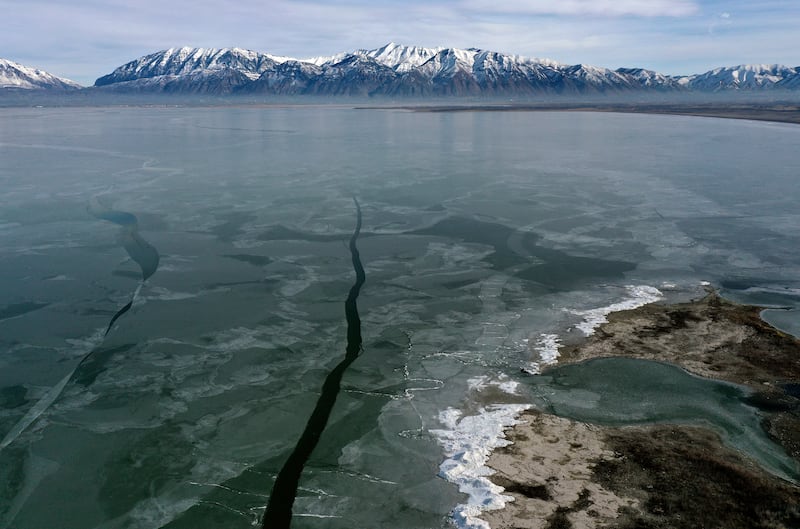Utah Lake is a unique body of water, the freshwater remnant of ancient Lake Bonneville. At 150 square miles, she is one of America’s largest natural lakes.
The town of Lehi, viewed from the south shore at Lincoln Point, disappears behind the curvature of the earth. Utah Lake is shallow, silty, and broad, but unlike the rest of the Great Basin’s valley lakes, such as the Great Salt, Sevier, Mono, Walker, and Pyramid, she is neither saline nor sterile. Her waters have sustained life, human and nonhuman, in Utah Valley for millennia.
As such, she merits careful consideration.
We treated her poorly for a century and a half. Unregulated fishing and imprudent irrigation practices eliminated her cutthroat trout, 40-pound specimens pioneer anglers proudly displayed. The Utah Lake sculpin is now extinct, as are most of the lake’s shellfish. Introduced eels, salmon, grayling, even goldfish (none of which survive) and carp (which flourish) destabilized the lake’s ecology. We directed untreated human sewage into the lake as late as 1967, and current flows of treated sewage and excess fertilizer contribute to algal blooms.
Despite it all, Utah Lake is alive and beautiful. If some have turned their backs on our valley lakes to the attractions of the mountains and canyons, and if the dozen resorts that surrounded the lake are gone, many of us — boaters, hunters, anglers, birders, walkers — affirm a fond relationship.
The best place in the state to enjoy our spectacular sunsets is from the lake’s eastern shore, and the lake also reflects the winter sun onto Mount Timpanogos, illuminating its slopes and making it appear to float unanchored from the valley floor.
Significantly, the lake is in better shape today than 30 years ago due to ongoing work by concerned scientists and state agencies.
Utah Lake also remains wild.
Summer squalls produce dangerous swells, and winter ice comes on shore in surreal peaks of cobalt blue blocks. The lake supports deer and beaver, fox and weasel, white bass, and, increasingly, the endangered June sucker.
We have documented 302 bird species on the lake, more than a third of the total species seen in the U.S. Bald eagles winter here, fishing conspicuously on the ice. In spring, thousands of avocets and stilts nest in the lake’s sheltered bays; others nest all around it: ducks, cranes, hawks, warblers and blackbirds in their red, yellow and orange accessories. Vulnerable migrants, such as eared grebes that cannot take wing from land, rely on the lake for fuel as they make their twice-annual journeys between the Pacific and their northern breeding grounds. With the Great Salt Lake fast disappearing, Utah Lake is essential to many migrants’ survival.
A current scheme proposes to fix the lake by filling 20% of it with dredged mud.
Utahns are being asked to give away billions of dollars of shorefront, public land to private corporations. As compensation, developers promise a clear, blue lake that in slick, sponsored advertising looks like a Caribbean destination of white sand beaches.
But no lake is improved by filling it in with mud, plugging it with thousands of homes and crisscrossing its quiet, unbroken waters with congested highways on earthen dikes. When we look out over our valley’s lake, we want to see an expanse of shimmering water, not a cheerless skyline of medium-density, low-rise apartments.
Filling in a natural lake would be inconceivable almost anywhere democracy works. Can we imagine Nevada’s citizens allowing legislators to fill in parts of Lake Tahoe; Seattleites covering even fractions of Lake Washington with dirt; or Minnesotans permitting the infill of even one of their 10,000 lakes?
And if covering one-fifth of the lake were to be a financial success (how not, if developers get free real estate?), what will prevent a future alliance of legislators and developers from filling in the rest of it, shore to shore?
When we return to the landscapes of our childhoods, we half expect the meadows and woodlots we rambled to be replaced by housing tracts and highway interchanges.
Such growth, as essential as it may be to a vibrant state economy, overlays our remembered pasts. Progress, sprawl, whatever you want to call it, usually gets its way, and we have conceded a lot of good ground.
But please, not the lake.
Like our mountains and streams, she is meant to be ours forever, a shared birthright we have no right to sacrifice for a mess of pottage.
Shawn Miller is a professor of history at Brigham Young University. He is a member of Conserve Utah Valley’s advisory board and currently serves as chair of the Provo Agricultural Commission, which works to promote and protect family farms.

